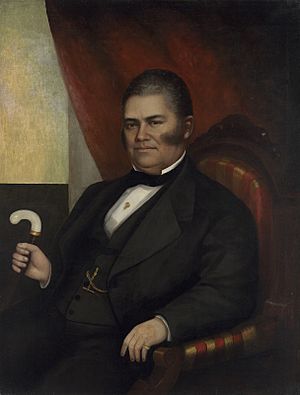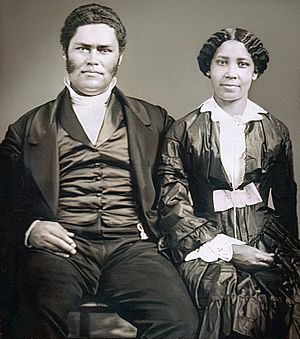John Jones (abolitionist) facts for kids
Quick facts for kids
John Jones
|
|
|---|---|

John Jones c. 1865
|
|
| Born | 1816 Green City, North Carolina, US
|
| Died | May 27, 1879 (age 63–64) Chicago, Illinois, US
|
| Occupation | Tailor, politician |
| Spouse(s) | Mary Jane Richardson Jones |
| Children | 1 |
John Jones (born 1816 – died 1879) was an important American leader. He was an abolitionist, which means he worked to end slavery. He was also a successful businessman, a leader for civil rights, and a kind person who gave money to help others.
John Jones was born in North Carolina. He later lived in Tennessee. In 1845, he moved to Chicago with very little money. But he became a very important African-American person in early Chicago history. He led a fight to get rid of the Black Codes in Illinois. These were unfair laws against black people. He was the first African-American to win a public job in Illinois. In 1870, he was the first black man in Illinois to be on a grand jury. In 1871, he became a notary public. That same year, he was elected to the Cook County Commission. He also became one of Chicago's richest men. He earned his money from his successful tailoring business.
John and his wife, Mary Jones, strongly opposed slavery. They were also very generous. They made their home a safe stop on the Underground Railroad. This was a secret network that helped people escape slavery. Their home was a busy place for people fighting slavery before the Civil War. The couple helped hundreds of people who were running away from slavery. John Jones passed away in 1879.
Contents
John Jones's Early Life
John Jones was born in Green City, North Carolina, in 1816. His mother was biracial and free. His father was German-American. For much of his early life, John was an indentured servant. This means he worked for someone for a set time to learn a skill. He trained as a tailor in Memphis, Tennessee.
In 1841, John married Mary Jane Richardson. She was born in 1819. Her father, Elijah Richardson, was a free black blacksmith. John first met Mary in Tennessee. He moved to Alton, Illinois to be with her. Their daughter, Lavinia, was born in 1843.
John and Mary were always careful about their freedom. They got new copies of their freedom papers in Alton in 1844. The young family moved to Chicago in March 1845. Chicago was a new city then. They were drawn to Chicago because it had a strong anti-slavery movement. On their trip, they were thought to be runaway slaves. They were held for a short time. But their stagecoach driver helped them get free.
Starting a New Life in Chicago
When John and Mary arrived in Chicago, they had only $3.50. This was a very small amount of money. They had to pawn a watch to pay for rent and two stoves. A black grocer, O. G. Hanson, gave them $2 in credit.
John Jones's tailoring business did very well. By 1850, they could afford to buy their own home. When they first came to Chicago, neither John nor Mary could read or write. But they quickly taught themselves. They believed reading was important for freedom. John wrote that "reading makes a free man."
In his early years in Chicago, John became good friends with other abolitionists. These included Lemuel Covell Paine Freer and Dr. Charles V. Dyer. John said they taught him to read and write. They also taught him about business and buying land. Besides his tailoring business, John bought land. This land later became the first working-class neighborhood for black families in Chicago.
Fighting for Rights in Chicago
The Joneses became part of a small black community in Chicago. When they arrived, there were only about 140 black people. The Joneses joined the Liberty Party. They made their family home the second stop on the Underground Railroad in Chicago.
John's tailoring business grew. At the same time, Mary managed their home. It became a center for black activism. She helped organize resistance against the Black Codes. These were unfair laws. She also fought against other strict laws like the Fugitive Slave Act.
Their friends included famous abolitionists like Frederick Douglass. Douglass introduced them to John Brown. Brown and his friends stayed with the Joneses. Mary described them as "the roughest looking men I ever saw." They were on their way to their raid on Harpers Ferry. The Joneses were not violent. They did not support Brown's plan for a violent slave uprising.
John Jones was very important in Chicago’s Underground Railroad. In 1854, he opened a "General Intelligence Office" at 88 Dearborn Street. This office was a main communication center for black people. Both free and escaped slaves used it. It stayed open from 1854 until the end of the Civil War. In 1861, the Joneses helped start Olivet Baptist Church. This church had the first library open to black people in Chicago.
Ending Illinois's Black Codes
As early as 1847, John Jones made it his main goal to get rid of Illinois's racist black laws. Illinois had its own version of a Black law. It was first passed in 1819. These laws controlled black people moving into Illinois. A law in 1853 even completely stopped black immigration. These laws also kept black people from serving on juries. They also could not join the Illinois state militia.
John's first try to repeal these laws was writing articles. He wrote a series of columns in the Western Citizen in 1847. In that same year, he started working closely with his friend Frederick Douglass. In December 1850, Jones started a petition. Black residents of the state signed it. It asked Illinois lawmakers to repeal the Black Laws. In 1864, the Chicago Tribune published a pamphlet by Jones. It was called “The Black Laws of Illinois and a Few Reasons Why They Should Be Repealed.” It was not until 1865 that Illinois finally removed these unfair laws.
John Jones's Later Years

In 1871, John Jones was elected as a Cook County Commissioner. He was the first African-American to be elected to a public job in Illinois. In that same year, the Great Chicago Fire happened. It destroyed both the Jones family home and their four-story tailoring business. Their property was worth a lot of money.
The family was able to rebuild. They built a new house near Prairie Avenue. John's tailoring business also started again in a new place. He kept working until he retired in 1873.
John Jones died on May 27, 1879. He passed away from a kidney disease called Bright's disease. His wife, Mary, was in charge of his will. She inherited his fortune. She became very wealthy on her own. His property was worth over $70,000. He had been one of Chicago's richest men. John's tailoring business was taken over by Lloyd Garrison Wheeler. He was a friend of the family. Mary Jones remained an important person in Chicago until she died in 1909. The Joneses are buried next to each other in Chicago's Graceland Cemetery.


